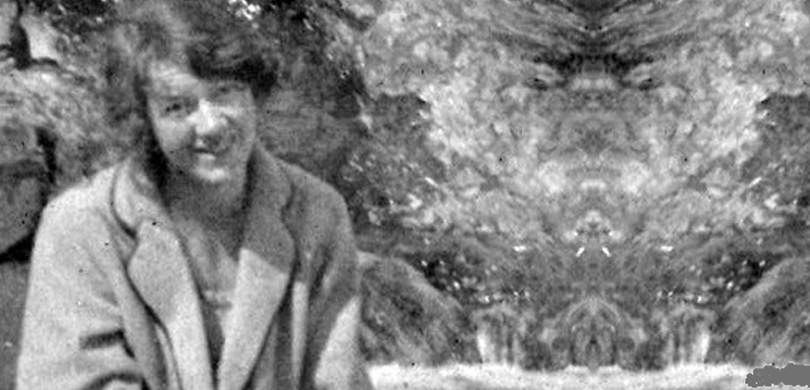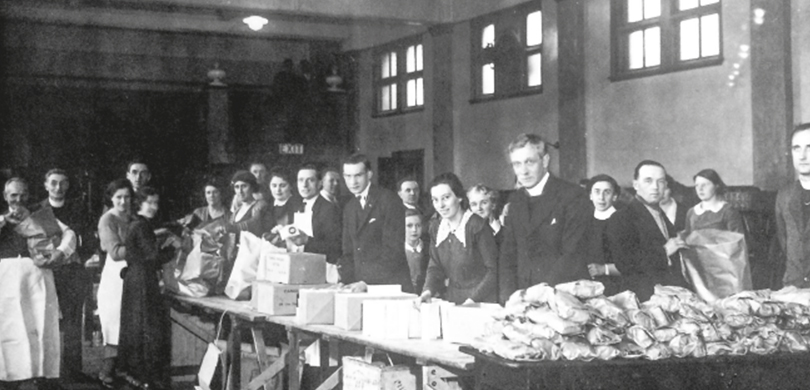A CENTURY OF WOMEN - 1930s
Introduction
Beginning with the financial fall-out from the Wall-Street crash and ending with the outbreak of World War II, the decade of the 1930s was marked by both economic bleakness and political extremism, not only in Ireland but also across the wider world. Post World War I economic depression, exacerbated by the crisis in the financial sector, hit industries hard and the consequent rise in unemployment proved catastrophic for many families.
Context
The Northern Ireland Parliament returned two Unionist women in this decade; Margaret Waring who served from 1929 to 1933 and Dehra Parker, regarded as a staunch supporter of the Unionist regime, who retained her seat for a total of thirty-five years. Participation at local government level enabled women to address specific concerns, but female representation continued to be concentrated in the least influential positions. For example, Diane Urquhart notes that of the thirty-two rural district councils in the period up to 1940, 53% had no female representative, while in the same period 72% of the more powerful urban district councils lacked any women members. The expectation of early suffragists that representation at local government level would be a powerful instrument for women was not met during the first half of the twentieth century. Several reasons are suggested for their limited engagement, including cost, time constraints, lack of experience or electoral support and a general indifference around local politics. Nonetheless, it is suggested that serving as Poor Law Guardians or Local Councillors did provide a minority of women with valuable experience of civic affairs and public duty.
Throughout this decade, Northern Ireland’s major industries of shipbuilding, construction and textile were all severely hit by the international economic crisis and, while other major British cities suffered a similar fate, the Government of Ireland Act ensured that Northern Ireland’s new local parliament had little control over the region’s finances. With 28% of the insured workforce unemployed in 1929, poverty was pervasive. In December 1930, those seeking work numbered nearly 100,000 in Belfast alone and the subsequent hardship had a devastating effect on the lives of the vulnerable. Moreover, whilst linen remained the highest employer of women, this industry was characterised by low wages and long hours. Many labourers’ homes (owned by Belfast Corporation) were declared ‘unfit for habitation’, with residents living below the poverty line. A series of surveys carried out during this decade highlighted the links between poverty and the high rates of maternal mortality and malnutrition. Infant mortality rates also rose, especially in Belfast, which had had the lowest infant mortality rate in the British Isles in 1901, but the highest in 1938 at 78 per 1000 births. ‘Whooping cough, influenza and measles killed 3 times as many in late 1930s Belfast than in similar cities across the Irish sea.’ However, while the struggle to control family size was not generally regarded as important, or even acceptable, a few pioneers began what was to be a long and controversial campaign to provide women with advice on birth control.
The depression of the 1930s was not just depressing but degrading - unemployment benefit was very limited, and married women were not entitled to any benefit at all. The outdoor relief system provided ‘chits’ in return for work; these could be redeemed for food at certain shops, but the public posting of receipt of such benefits ensured maximum embarrassment for the family. Poverty – fuelled by anger and frustration – leading to the Outdoor Relief Strike of 1932, an event that briefly unified the poor of both Protestant and Catholic communities. Twenty-two year old Betty Sinclair, linen worker, trade unionist and a member of the recently formed Revolutionary Workers Party, was secretary of the Strike Committee in North Belfast. From 3rd to 11th October, Catholic and Protestant workers made common cause against the ruling class, holding mass marches, rallies and demonstrations. In the ensuing violence of the final days of the Strike, engrained sectarian tensions were exploited by the authorities, and the strike was broken up by a combination of police repression, minor concessions and witch-hunts against Republicans and communists, whose actions and ideologies were conflicted in the minds of the establishment. Sectarian riots followed, spiralling in 1935, which saw the forcible displacement of many Catholics from their burning homes.
The rise of extreme right and left wing political ideologies in Northern Ireland reflected those felt with particular force in Russia, Spain and Germany. Conservative ideology was marked by an adulation of motherhood and a heightened emphasis on women’s domestic role. Many European governments, including those in power in the North and South of Ireland, imposed restrictions on women, which particularly impacted on civil servants and schoolteachers. Support for both Communist and Fascist ideologies can be seen throughout Ireland at this time. Educational visits to Moscow were organised by the ‘Friends of Russia’ – a small but vociferous group of Communists who organized opposition to Capitalist ideology and politics. Following their experience of visiting the Soviet Union, two Belfast men formed a Belfast branch of the organization in 1933. By 1937, the RUC reported that this group ‘attracted considerable support’. In 1936, the outbreak of the Spanish Civil War provided an opportunity for those wishing to show solidarity with Spanish Republican opponents of Franco, establishing Aid for Spain and Arms for Spain Committees. Seven men from Belfast’s Shankill Road were among approximately 100 from Northern Ireland who signed up to fight for the International Brigade: while women expressed their support through public meetings and fund-raising in organisations such as the International Brigade Dependents’ Committee and the Women’s Committee of the Spanish Relief Fund. Betty Sinclair and Sadie Menzies were amongst those lending their support to the war against fascism, while Eleanor Midgley, the wife of the leader of the Northern Ireland Labour Party and Secretary to the Relief Fund, was able to report in March 1937 that two consignments of knitted goods and clothes had already been sent to aid Spanish civilians and that another would follow.
Those on the extreme right also gained support; the Ulster Women’s Units of British Fascists formed branches throughout the north, while Lady Londonderry publicly declared her admiration for Hitler’s campaign against Communism.
Against this background, any progress in women’s role in social, political and economic life was extremely limited. Although women could now take university degrees, only nine women lecturers were appointed by Queen's University between 1931 and 1949, and at least two of these were appointed as a matter of wartime expediency. With little support from patrons or publishers, the extent of female engagement in cultural activities is again difficult to gauge with any degree of accuracy. Helen Waddell’s 1933 historical novel Peter Abelard was a bestseller and her play, The Abbe Prevost was first staged in 1935. Although little known in wider circles, the Dictionary of Twentieth-century Art does record a range of women from the north whose work merited the attention of contemporaries. For example, Margaret Clarke (nee Crilley) from Newry was an accomplished figure and landscape painter, Emily D. Corry focused on still life and portraiture, while Dunmurry woman, Anne Jury, was well-known for her representations of flowers, landscapes and animals. Olive Henry, a keen photographer, worked in stained glass, and Ann Acheson from Portadown was a sculptor. There is little doubt there were other women whose cultural talents could be brought to light by further research.
TIMELINE
1931
- Revolutionary Workers’ Group is formed; the first Communist organisation in Belfast.
1932
- Cumann mBan holds National Flag Day to aid struggling people of Belfast.
- Outdoor Relief Strike takes place, with Betty Sinclair as secretary of the Strike Committee.
- First Federation of Women’s Institute NI is established in Garvagh, Londonderry.
1933
- January: Sarah Grimley and Mary Donnelly, of Belfast Cumann na mBan, receive two and three-month jail sentences respectively for posting Republican literature in opposition to the visit of the Prince of Wales.
- Hanna Sheehy-Skeffington is arrested and imprisoned in Armagh for defying an exclusion order barring her from the six counties.
- Betty Sinclair is invited to study at the Lenin School in Moscow as a member of the Communist Party of Ireland.
- Belfast-based Olga Felden, playwright and novelist publishes Island Stories which, according to the Times Literary Supplement, had ‘an exhilarating quality’.
- 1935
- Amidst sectarian rioting, Charlotte Despard moves from Dublin to Belfast to raise support for her Christian-based Communism.
- The Employment of Women and Young Persons Act is passed.
1936
- The first clinic in Northern Ireland to offer birth control is launched as part of the Marie Stopes organisation. It will close its doors in 1947. Another clinic, to be based at the Royal Maternity Hospital and run on voluntary lines by Dr Olive Anderson, will open in 1940.
1937
- Launch of Belfast Corporation Housing Scheme
1936-1939
- Support amongst left-wing activists for the Spanish Civil War. Belfast Trades Council sets up a committee to collect money and food, and women are also active in the International Brigade Dependent’s Committee and the Women’s Committee of the Spanish Relief Fund.
1938
- Born in Enniskillen in 1915, Joan Trimble’s 1938 recital at the RCM, together with her sister Valerie, proves to be an important breakthrough, her future compositions will include the 1957 opera Blind Rafferty, the third opera commissioned by the BBC for television, and the first television opera written by a female composer.
1939
- The Infanticide Act 1939 extends the defence for a woman who deliberately kills her newborn child to cases where "at the time of the act or omission the balance of her mind was disturbed by reason of her not having fully recovered from the effect of giving birth to the child or by reason of the effect of lactation consequent upon the birth of the child."
- WWII is declared in September
READING
Myrtle Hill, Women in Ireland: a century of change (Belfast: Blackstaff Press, 2003).
Greta Jones, “Marie Stopes in Ireland - The Mother's Clinic in Belfast, 1936-47”, Social History of Medicine, Volume 5, Issue 2, 1 August 1992, Pages 255–277.
Hazel Morrissey, Oral History: Betty Sinclair: ‘A Woman’s Fight for Socialism, 1910-1981’, Saothair na hEireann Journal of the Irish Labour History Society (1983), pp. 121-32.
Diane Urquhart, Women in Ulster Politics 1890-1940 (Dublin: Irish Academic Press, 2000).
David Bleakley, Saidie Patterson: Irish Peacemaker (Belfast: Blackstaff Press, 1980).
Theo Snoddy, Dictionary of Irish Artists: 20th Century (Merlin Publishing; 2nd edition, 2002)
Nancy Kinghan, United We Stood: The Story of the Ulster Women’s Unionist Council 1911-1974 (Belfast: Appletree Press, 1975)
Jennifer FitzGerald, Helen Waddell and Maude Clarke: Irishwomen, Friends and Scholars (Oxford: Peter Lang, 2012)
Jonathan Bardon, A History of Ulster (Belfast: Blackstaff Press, 1992)

